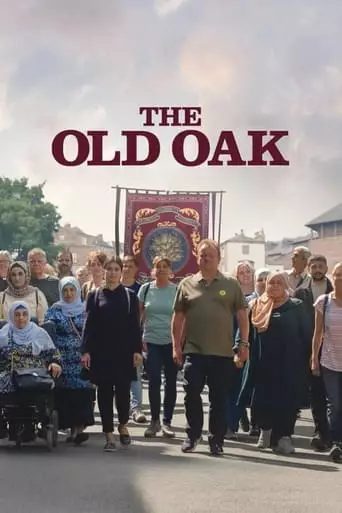A pub landlord in a previously thriving mining community struggles to hold onto his pub. Meanwhile, tensions rise in the town when Syrian refugees are placed in the empty houses in the community.
The Old Oak (2023) by Ken Loach is a poignant social drama that tackles the themes of immigration, community tensions, and human resilience. Set in a small, post-industrial village in the northeast of England, it explores the complex dynamics between locals struggling with economic decline and newly arrived Syrian refugees. The film touches on the themes of belonging, division, and the shared struggle of working-class communities.
Plot Summary
The narrative revolves around TJ Ballantyne, an aging, widowed pub owner, whose once-thriving business now symbolizes a dwindling community. His life is disrupted when a group of Syrian refugees arrives in the village, among them Yara, a strong-willed young woman determined to make the best of a challenging situation. Yara strikes up an unlikely friendship with TJ, and the two try to navigate the tensions between the locals and the newcomers. TJ’s once solitary life begins to intersect with the refugees’ journey, leading to moments of shared understanding, conflict, and gradual change. However, the film does not shy away from depicting the raw hostility some locals feel towards the refugees, highlighting the cultural and economic struggles that breed fear and resentment.
10 Reasons to Watch The Old Oak
- Ken Loach’s Final Film: This movie is likely Ken Loach’s swan song, marking the end of a long and impactful filmmaking career focused on working-class struggles. For fans of his work, it’s a must-see conclusion to his exploration of social justice.
- Authentic Social Commentary: Loach’s trademark style shines through in The Old Oak, addressing issues of immigration, economic hardship, and the conflict between established communities and newcomers, making it highly relevant to current global debates on migration and xenophobia.
- Complex Characters: The film excels in portraying multifaceted characters. TJ’s journey from isolation to connection, alongside Yara’s resilience and strength, creates a deeply human story of mutual growth and empathy.
- Strong Performances: Dave Turner and Ebla Mari deliver compelling performances, with Mari’s portrayal of Yara being particularly noted for its emotional depth and strength. Her character’s refusal to be silenced speaks to the universal struggle for dignity in the face of adversity
- Realistic Depictions of Struggle: The film doesn’t sugarcoat the difficulties faced by both the refugees and the local residents. It provides an honest look at the hardships that define their lives, including economic distress, loneliness, and the complexities of forming new bonds.
- Focus on Human Connection: Despite the tension, The Old Oak emphasizes the potential for human connection across cultural divides. It explores how shared struggles can unite people, even those from vastly different backgrounds
- Cultural Tension and Reconciliation: The film delves into the raw emotions that often accompany the arrival of refugees in communities, particularly in rural areas that feel abandoned by the larger system. It portrays the difficult but essential process of overcoming suspicion and fear through dialogue and action
- Stunning Cinematography: The film uses simple yet evocative cinematography to highlight the stark contrasts of rural England and the challenges of integration. The scenes feel almost documentary-like, contributing to the authenticity of the story
- A Powerful Message of Hope: Although the film doesn’t shy away from harsh realities, it ultimately delivers a message of hope. It suggests that even in the most fractured communities, the possibility for healing and change exists when people reach out to one another
- Timely and Thought-Provoking: The Old Oak is particularly timely in its examination of the refugee crisis and the rise of nationalism. It invites viewers to reflect on the human side of these global issues and challenges the idea that we should fear change
What Will You Feel After Watching It?
Watching The Old Oak will leave you with a mix of emotions—hope, sadness, and perhaps a sense of discomfort. Loach’s raw depiction of human struggle and resilience often leads to an emotional response, whether from empathy for the characters or frustration with the harsh realities they face. You might find yourself reflecting on the complexities of immigration, the challenges of reconciling past trauma with present realities, and the importance of compassion in times of social upheaval.
The film will likely stir feelings of admiration for the resilience of the refugees, while also prompting critical thought on the difficult journey of reintegrating marginalized groups into society. The eventual optimism of the film, despite its raw and gritty depiction of society’s flaws, can evoke a sense of bittersweet hope that change, though difficult, is always possible.
In conclusion, The Old Oak is a must-watch for those interested in thoughtful, socially conscious cinema. It’s a reflection on the challenges we face as a society, the bonds that hold us together, and the human capacity for empathy and transformation. It’s a film that will make you think long after the credits roll.

